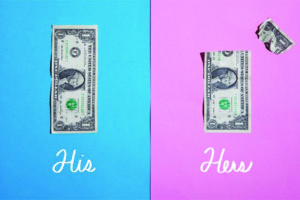Today is Equal Pay Day, a symbolic day during the calendar year when women’s earnings equal men’s earnings from the previous year. So, basically women have to work a little more than three months longer than a man in a comparable position to earn what he made the previous year. But, hey we’ve come a long way, baby. Not! In 2005, Equal Pay Day fell on April 19. Whoop – and please read that whoop with dripping sarcasm. We’ve got a long way to go.

Equal Pay Day has a relatively short, but interesting history. It was begun in 1998 by the National Committee on Pay Equality, a coalition of equal rights groups and professional associations that worked to achieve pay parity.
But let’s backtrack a bit to 1963, the year President John F. Kennedy signed the Equal Pay Law that made it illegal for employers to pay women a lower wage than a man in a similar position. At that time, women earned 59 cents to the dollar earned by men.
In 2009, President Barack Obama signed the Lily Ledbetter Fair Pay Act which “prohibits sex-based wage discrimination between men and women in the same establishment who perform the jobs that require substantially equal skill, effort, and responsibility under similar working conditions.” Here’s the link if you want to read the whole act:
https://www.eeoc.gov/eeoc/publications/brochure-equal_pay_and_ledbetter_act.cfm
That should have helped, right?
Well, yes, but efforts to advance it were thwarted when in 2014 Senate Republicans blocked a measure known as the Paycheck Fairness Act that would have required employers to disclose more information about workers’ salary and compensation packages. The bill would have also made it illegal for companies to punish employees who discuss their salaries.
But, surely, the pay gap is closing and women’s rights are being advanced every day?
Not exactly. In fact, many equal rights groups complain that we’re going in the opposite direction and that women’s rights are being eroded. Just this past March 27, President Donald Trump signed an executive order that revoked the 2014 Fair Pay and Safe Workplaces Order put in place by President Obama. This act ensured that companies with federal contracts had to comply with several labor and civil rights laws including paycheck transparency and a ban on forced arbitration clauses for sexual discrimination, harassment and assault. What does this mean?
Forced arbitration clauses are often used to keep sex discrimination claims out of the courts and off the public record. Banning these gave victims a safer environment in which to seek justice and also shone a spotlight on these cases, possibly emboldening other victims to come forward. Trump’s order to overturn this ban makes it possible for companies with federal contracts to force sexual harassment and discrimination cases behind closed doors where others, including company employees and the public, may never learn about the cases brought against the company. And, with the paycheck transparency mandate lifted, businesses with federal contracts no longer had to reveal salaries and pay scales for their employees, leaving workers to have to negotiate pay hikes blindly. Opponents of Trump’s executive order say that it sets women back to the mid-century when a woman’s place was in the home but if she chose to work, or had to, her work was not valued as highly as a man’s.
Will woman ever achieve pay parity and equal rights? That’s a loaded question and the answer is unknown. At present, according to a 2016 study, in the U.S., white non-Hispanic women earn 83 cents for every dollar a man earns. Black women earn 66 cents while Hispanic women earn 60 cents. The currently accepted average statistic is that women, in general, earn 77 cents for every dollar a man in a similar position earns.
It’s Equal Pay Day but it’s not a day to celebrate. We can’t, until women earn the same pay as men and are treated fairly and equally.
YOU MAY ALSO LIKE:
Addicted to Stress? Many Women Are
International Women’s Day 2017